| Total eclipse | |||||||||||||||||
 Totality as viewed from San Jose, California, 8:11 UTC Totality as viewed from San Jose, California, 8:11 UTC | |||||||||||||||||
| Date | December 21, 2010 | ||||||||||||||||
|---|---|---|---|---|---|---|---|---|---|---|---|---|---|---|---|---|---|
| Gamma | 0.3213 | ||||||||||||||||
| Magnitude | 1.2576 | ||||||||||||||||
| Saros cycle | 125 (48 of 72) | ||||||||||||||||
| Totality | 72 minutes, 21 seconds | ||||||||||||||||
| Partiality | 208 minutes, 41 seconds | ||||||||||||||||
| Penumbral | 335 minutes, 7 seconds | ||||||||||||||||
| |||||||||||||||||
| ← June 2010June 2011 → | |||||||||||||||||
A total lunar eclipse occurred at the Moon’s descending node of orbit on Tuesday, December 21, 2010, with an umbral magnitude of 1.2576. A lunar eclipse occurs when the Moon moves into the Earth's shadow, causing the Moon to be darkened. A total lunar eclipse occurs when the Moon's near side entirely passes into the Earth's umbral shadow. Unlike a solar eclipse, which can only be viewed from a relatively small area of the world, a lunar eclipse may be viewed from anywhere on the night side of Earth. A total lunar eclipse can last up to nearly two hours, while a total solar eclipse lasts only a few minutes at any given place, because the Moon's shadow is smaller. Occurring about 4 days before apogee (on December 25, 2010, at 7:15 UTC), the Moon's apparent diameter was smaller.
This eclipse was notable in that it coincided with the date of the Winter solstice in the Northern Hemisphere and Summer solstice in the Southern Hemisphere. It was the first total lunar eclipse to occur on the day of the Northern Winter Solstice (Southern Summer Solstice) since 1638, and only the second in the Common Era.
Visibility
The eclipse was completely visible over North America and the eastern Pacific Ocean, seen rising over east Asia and Australia and setting over South America, west Africa, and Europe.

|
 Hourly motion shown right to left |
 The Moon's hourly motion across the Earth's shadow in the constellation of Taurus. |
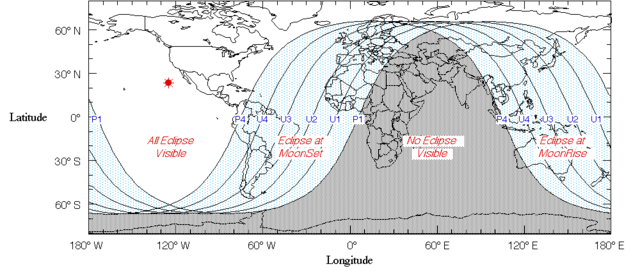 Visibility map | ||
Images
 These simulated views of the Earth from the center of the Moon during the lunar eclipse show where the eclipse is visible on Earth. |

Gallery
 Progression from São Paulo, Brazil | |
 Progression from Anchorage, Alaska | |
 Panorama showing the view from the site of the VLT | |
 Sequence from Toronto, Ontario, Canada (Sequence is in 15-minute increments, with 5-minute increments up until totality at 8:17 am UTC) |
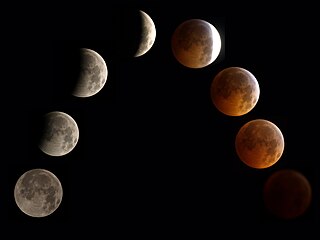 Progression from Toronto, Canada |
 From Jacksonville, Florida, 8:29 UTC - 10:06 UTC |
 From Easton, Pennsylvania |
Individual shots, sorted by time:
-
 From New York City, New York, 5:35 UTC
From New York City, New York, 5:35 UTC
-
 From Arlington County, Virginia, ~7:30 UTC
From Arlington County, Virginia, ~7:30 UTC
-
 From New York City, New York, 7:38 UTC
From New York City, New York, 7:38 UTC
-
 From Seattle, Washington, beginning of totality, 7:41 UTC
From Seattle, Washington, beginning of totality, 7:41 UTC
-
From the Lower Mainland of British Columbia, Canada, 7:46 UTC
-
 From Miami, Florida, 7:52 UTC
From Miami, Florida, 7:52 UTC
-
 From Richardson, Texas, 7:53 UTC
From Richardson, Texas, 7:53 UTC
-
From Dover, Delaware, 7:54 UTC
-
Lower Mainland of British Columbia, Canada during totality, 8:21 UTC
-
 From Toronto, Ontario, Canada, 8:26 UTC
From Toronto, Ontario, Canada, 8:26 UTC
-
 From Orlando, Florida, 8:28 UTC
From Orlando, Florida, 8:28 UTC
-
From Jacksonville, Florida, 8:30 UTC
-
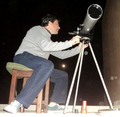 Amateur scientists observing eclipse in Villa Gesell, Argentina, 8:34 UTC
Amateur scientists observing eclipse in Villa Gesell, Argentina, 8:34 UTC
-
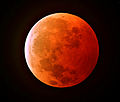 From Tucson, Arizona, 8:44 UTC
From Tucson, Arizona, 8:44 UTC
-
From Longjing District, Taichung, Taiwan at moonrise, 9:45 UTC
Animations:
-
 Animated Simulation
Animated Simulation
-
 Time-lapsed animation
Time-lapsed animation
Miami, Florida
Timing
In North America, the eclipse was visible in its entirety on 21 December 2010, from 12:27 a.m. to 6:06 a.m. Eastern Standard Time. In the Central Standard Time zone and west, the eclipse began the night of 20 December. Observers along South America's east coast missed the late stages of the eclipse because they occurred after moon-set.
Likewise much of Europe and Africa experienced moon-set while the eclipse was in progress. In Europe, only those observers in northern Scandinavia (including Iceland), Ireland and Britain could observe the entire event. For observers in eastern Asia the moon rose in eclipse. The eclipse was not visible from southern and eastern Africa, the Middle East or South Asia. In Japan and northeastern Asia, the eclipse's end was visible, with the moon rising at sunset. In the Philippines it was observable as a partial lunar eclipse just after sunset.
Predictions suggested that the total eclipse may appear unusually orange or red, as a result of the eruption of Mount Merapi in Indonesia on 26 October.
| Event | HAST (UTC-10) |
AKST (UTC−9) |
PST (UTC−8) |
MST (UTC−7) |
CST (UTC−6) |
EST (UTC−5) |
AST (UTC−4) |
UTC (UTC) |
|---|---|---|---|---|---|---|---|---|
| Start penumbral (P1) | 7:29 pm | 8:29 pm | 9:29 pm | 10:29 pm | 11:29 pm | 12:29 am | 1:29 am | 5:29 am |
| Start umbral (U1) | 8:33 pm | 9:33 pm | 10:33 pm | 11:33 pm | 12:33 am | 1:33 am | 2:33 am | 6:33 am |
| Start total (U2) | 9:41 pm | 10:41 pm | 11:41 pm | 12:41 am | 1:41 am | 2:41 am | 3:41 am | 7:41 am |
| Greatest eclipse | 10:17 pm | 11:17 pm | 12:17 am | 1:17 am | 2:17 am | 3:17 am | 4:17 am | 8:17 am |
| End total (U3) | 10:53 pm | 11:53 pm | 12:53 am | 1:53 am | 2:53 am | 3:53 am | 4:53 am | 8:53 am |
| End umbral (U4) | 12:01 am | 1:01 am | 2:01 am | 3:01 am | 4:01 am | 5:01 am | 6:01 am | 10:01 am |
| End penumbral (P4) | 1:04 am | 2:04 am | 3:04 am | 4:04 am | 5:04 am | 6:04 am | 7:04 am | 11:04 am |
| (*) before midnight on Monday night, 20 December | ||||||||
Eclipse details
Shown below is a table displaying details about this particular solar eclipse. It describes various parameters pertaining to this eclipse.
| Parameter | Value |
|---|---|
| Penumbral Magnitude | 2.28215 |
| Umbral Magnitude | 1.25759 |
| Gamma | 0.32139 |
| Sun Right Ascension | 17h57m09.6s |
| Sun Declination | -23°26'09.9" |
| Sun Semi-Diameter | 16'15.5" |
| Sun Equatorial Horizontal Parallax | 08.9" |
| Moon Right Ascension | 05h57m17.3s |
| Moon Declination | +23°44'47.8" |
| Moon Semi-Diameter | 15'52.1" |
| Moon Equatorial Horizontal Parallax | 0°58'14.3" |
| ΔT | 66.4 s |
Eclipse season
See also: Eclipse cycleThis eclipse is part of an eclipse season, a period, roughly every six months, when eclipses occur. Only two (or occasionally three) eclipse seasons occur each year, and each season lasts about 35 days and repeats just short of six months (173 days) later; thus two full eclipse seasons always occur each year. Either two or three eclipses happen each eclipse season. In the sequence below, each eclipse is separated by a fortnight.
| December 21 Descending node (full moon) |
January 4 Ascending node (new moon) |
|---|---|
 |

|
| Total lunar eclipse Lunar Saros 125 |
Partial solar eclipse Solar Saros 151 |
Related eclipses
Eclipses in 2010
- An annular solar eclipse on January 15.
- A partial lunar eclipse on June 26.
- A total solar eclipse on July 11.
- A total lunar eclipse on December 21.
Metonic
- Preceded by: Lunar eclipse of March 3, 2007
- Followed by: Lunar eclipse of October 8, 2014
Tzolkinex
- Preceded by: Lunar eclipse of November 9, 2003
- Followed by: Lunar eclipse of January 31, 2018
Half-Saros
- Preceded by: Solar eclipse of December 14, 2001
- Followed by: Solar eclipse of December 26, 2019
Tritos
- Preceded by: Lunar eclipse of January 21, 2000
- Followed by: Lunar eclipse of November 19, 2021
Lunar Saros 125
- Preceded by: Lunar eclipse of December 9, 1992
- Followed by: Lunar eclipse of December 31, 2028
Inex
- Preceded by: Lunar eclipse of January 10, 1982
- Followed by: Lunar eclipse of November 30, 2039
Triad
- Preceded by: Lunar eclipse of February 20, 1924
- Followed by: Lunar eclipse of October 21, 2097
Lunar eclipses of 2009–2013
This eclipse is a member of a semester series. An eclipse in a semester series of lunar eclipses repeats approximately every 177 days and 4 hours (a semester) at alternating nodes of the Moon's orbit.
The penumbral lunar eclipses on February 9, 2009 and August 6, 2009 occur in the previous lunar year eclipse set, and the lunar eclipses on April 25, 2013 (partial) and October 18, 2013 (penumbral) occur in the next lunar year eclipse set.
| Lunar eclipse series sets from 2009 to 2013 | ||||||||
|---|---|---|---|---|---|---|---|---|
| Ascending node | Descending node | |||||||
| Saros | Date Viewing |
Type Chart |
Gamma | Saros | Date Viewing |
Type Chart |
Gamma | |
| 110 | 2009 Jul 07
|
Penumbral
|
−1.4916 | 115
|
2009 Dec 31
|
Partial
|
0.9766 | |
120
|
2010 Jun 26
|
Partial
|
−0.7091 | 125
|
2010 Dec 21
|
Total
|
0.3214 | |
130
|
2011 Jun 15
|
Total
|
0.0897 | 135
|
2011 Dec 10
|
Total
|
−0.3882 | |
140
|
2012 Jun 04
|
Partial
|
0.8248 | 145 | 2012 Nov 28
|
Penumbral
|
−1.0869 | |
| 150 | 2013 May 25
|
Penumbral
|
1.5351 | |||||
Metonic series
The Metonic cycle repeats nearly exactly every 19 years and represents a Saros cycle plus one lunar year. Because it occurs on the same calendar date, the Earth's shadow will be in nearly the same location relative to the background stars.
| Ascending node | Descending node |
|---|---|
|
|
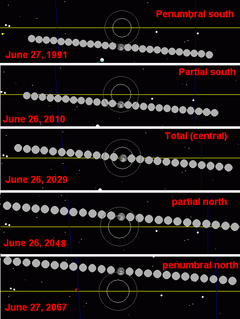
|

|
Tritos series
The tritos series repeats 31 days short of 11 years at alternating nodes. Sequential events have incremental Saros cycle indices.
This series produces 20 total eclipses between April 24, 1967 and August 11, 2185, only being partial on November 19, 2021.
| Tritos eclipse series (subset 1901–2087) | ||||||
|---|---|---|---|---|---|---|
| Descending node | Ascending node | |||||
| Saros | Date Viewing |
Type chart |
Saros | Date Viewing |
Type chart | |
| 115 | 1901 Oct 27
|
Partial
|
116 | 1912 Sep 26
|
Partial
| |
| 117 | 1923 Aug 26
|
Partial
|
118 | 1934 Jul 26
|
Partial
| |
| 119 | 1945 Jun 25
|
Partial
|
120 | 1956 May 24
|
Partial
| |
| 121 | 1967 Apr 24
|
Total
|
122 | 1978 Mar 24
|
Total
| |
| 123 | 1989 Feb 20
|
Total
|
124 | 2000 Jan 21
|
Total
| |
| 125 | 2010 Dec 21
|
Total
|
126 | 2021 Nov 19
|
Partial
| |
| 127 | 2032 Oct 18
|
Total
|
128 | 2043 Sep 19
|
Total
| |
| 129 | 2054 Aug 18
|
Total
|
130 | 2065 Jul 17
|
Total
| |
| 131 | 2076 Jun 17
|
Total
|
132 | 2087 May 17
|
Total
| |
| 133 | 2098 Apr 15
|
Total
| ||||
Saros 125
This eclipse is a part of Saros series 125, repeating every 18 years, 11 days, and containing 72 events. The series started with a penumbral lunar eclipse on July 17, 1163. It contains partial eclipses from January 17, 1470 through June 6, 1686; total eclipses from June 17, 1704 through March 19, 2155; and a second set of partial eclipses from March 29, 2173 through June 25, 2317. The series ends at member 72 as a penumbral eclipse on September 9, 2443.
The longest duration of totality was produced by member 37 at 100 minutes, 23 seconds on August 22, 1812. All eclipses in this series occur at the Moon’s descending node of orbit.
| Greatest | First | |||
|---|---|---|---|---|
| The greatest eclipse of the series occurred on 1812 Aug 22, lasting 100 minutes, 23 seconds. | Penumbral | Partial | Total | Central |
| 1163 Jul 17 |
1470 Jan 17 |
1704 Jun 17 |
1758 Jul 20 | |
| Last | ||||
| Central | Total | Partial | Penumbral | |
1920 Oct 27
|
2155 Mar 19 |
2317 Jun 25 |
2443 Sep 09 | |
Eclipses are tabulated in three columns; every third eclipse in the same column is one exeligmos apart, so they all cast shadows over approximately the same parts of the Earth.
| Series members 37–58 occur between 1801 and 2200: | |||||
|---|---|---|---|---|---|
| 37 | 38 | 39 | |||
| 1812 Aug 22 | 1830 Sep 02 | 1848 Sep 13 | |||
| 40 | 41 | 42 | |||
| 1866 Sep 24 | 1884 Oct 04 | 1902 Oct 17 | |||

|

| ||||
| 43 | 44 | 45 | |||
| 1920 Oct 27 | 1938 Nov 07 | 1956 Nov 18 | |||

|

|

|

|

|

|
| 46 | 47 | 48 | |||
| 1974 Nov 29 | 1992 Dec 09 | 2010 Dec 21 | |||

|

|

|

|

|

|
| 49 | 50 | 51 | |||
| 2028 Dec 31 | 2047 Jan 12 | 2065 Jan 22 | |||

|

|

|

|
||
| 52 | 53 | 54 | |||
| 2083 Feb 02 | 2101 Feb 14 | 2119 Feb 25 | |||
| 55 | 56 | 57 | |||
| 2137 Mar 07 | 2155 Mar 19 | 2173 Mar 29 | |||
| 58 | |||||
| 2191 Apr 09 | |||||
Half-Saros cycle
A lunar eclipse will be preceded and followed by solar eclipses by 9 years and 5.5 days (a half saros). This lunar eclipse is related to two annular solar eclipses of Solar Saros 132.
| December 14, 2001 | December 26, 2019 |
|---|---|

|
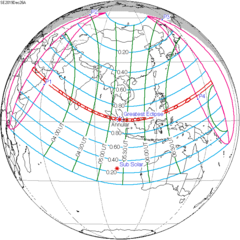
|
See also
- List of lunar eclipses
- List of 21st-century lunar eclipses
- June 2011 lunar eclipse
- December 2011 lunar eclipse
- File:2010-12-21 Lunar Eclipse Sketch.gif Chart
- 2010 12 21 – Lunar Eclipse in Jacksonville, FL
- 2010 12 21 – Lunar Eclipse Sequence
Notes
- "December 20–21, 2010 Total Lunar Eclipse (Blood Moon)". timeanddate. Retrieved 15 November 2024.
- "Moon Distances for London, United Kingdom, England". timeanddate. Retrieved 15 November 2024.
- "NASA Science News: Solstice Lunar Eclipse". Science.nasa.gov. 17 December 2010. Archived from the original on 5 November 2014. Retrieved 21 December 2010.
- "Lunar eclipse, winter solstice to coincide". Cbc.ca. 17 December 2010. Retrieved 21 December 2010.
- "Total Lunar Eclipse of 2010 Dec 21" (PDF). NASA. Retrieved 15 November 2024.
- Gupta, Yatharth (21 December 2010). "Total Eclipse of the Moon". Seattle. Retrieved 30 July 2020 – via Flickr.
- Greg (11 December 2010). "Total Lunar Eclipse of December 21, 2010". Outer Space Universe. Retrieved 3 January 2011.
- 2010 Dec 21 chart: Eclipse Predictions by Fred Espenak, NASA/GSFC
- ^ "What Time is the Lunar Eclipse 2010 Tonight?". City State Times. Archived from the original on 22 December 2010. Retrieved 21 December 2010.
- Roberts, Chris. "A historic eclipse: Volcano will tint the moon in rare Dec. 21 celestial dance". El Paso Times. Archived from the original on 29 July 2012.
- "Total Lunar Eclipse of 2010 Dec 21". EclipseWise.com. Retrieved 15 November 2024.
- van Gent, R.H. "Solar- and Lunar-Eclipse Predictions from Antiquity to the Present". A Catalogue of Eclipse Cycles. Utrecht University. Retrieved 6 October 2018.
- "NASA - Catalog of Lunar Eclipses of Saros 125". eclipse.gsfc.nasa.gov.
- Listing of Eclipses of series 125
- Mathematical Astronomy Morsels, Jean Meeus, p.110, Chapter 18, The half-saros
External links
- Worldwide viewing times for the December 2010 Total Lunar Eclipse
- How to Photograph the Lunar Eclipse from the NY Institute of Photography Archived 14 July 2011 at the Wayback Machine
- "Full & Last Lunar Eclipse Of 2010 On December 21st". Tech Dreams. 12 December 2010. Retrieved 30 July 2020.
- 2010 Dec 21 chart: Eclipse Predictions by Fred Espenak, NASA/GSFC
- "Total Lunar Eclipse of 21 Dec, 2010 AD". hermit.org. Retrieved 30 July 2020.
- "Animation of the December 21, 2010 eclipse" at shadowandsubstance.com
- Astronomical Society of the Pacific eclipse times and questions & answers Archived 23 December 2010 at the Wayback Machine
- "Total Lunar Eclipse: Dec. 21, 2010". Spaceweather.com. Retrieved 30 July 2020.


